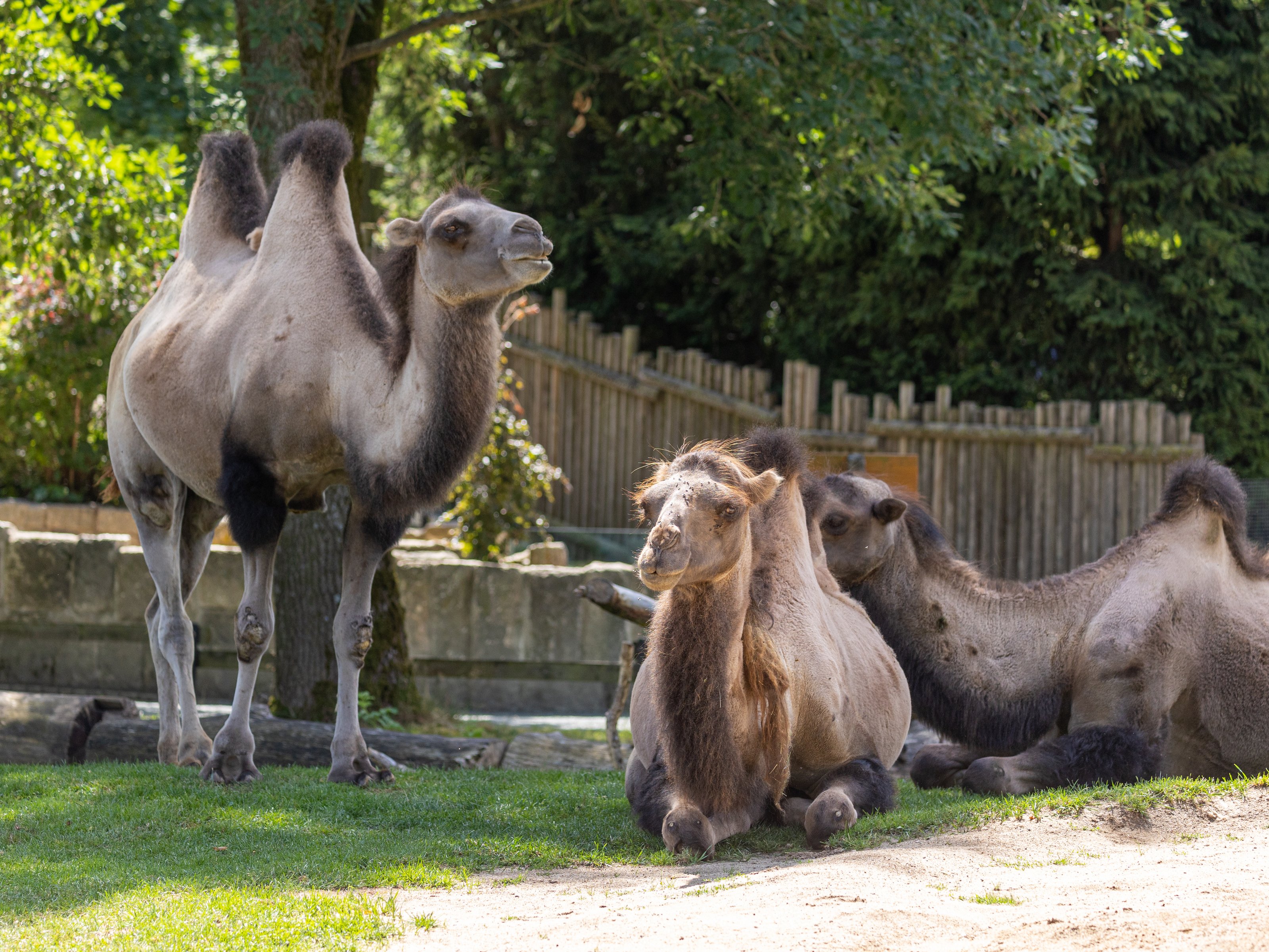
Station 19 Bactrian Camel
Well, unfortunately, it is over with the beautiful fairy tale that camels carry water reserves in their humps through the desert. Nevertheless, these animals, wonderfully adapted to desert life, can survive dry periods unscathed. Fat stores are created in the humps and serve only as an energy reserve, with the side effect that these fat pads protect wonderfully from heat and cold. In the case of extreme water shortage, fluid is withdrawn not from the blood, as in other mammals, but primarily from the muscles and various organs. On the other hand, liquid can be accumulated in the three forestomachs. Very concentrated urine and dry faeces also help against fluid loss. Camels have the peculiarity to compensate their liquid deficit very quickly after overcoming thirst, which, on the other hand, would be fatal for humans, for example.
Thus, a camel can consume 135 litres of water within ten minutes.
Have you ever looked at the long eyelashes and the closable nostrils? A sandstorm can hardly do any damage there.
Bactrian camels can tolerate temperature differences of up to 80°C. To do this, they lay close together to better withstand cold at night and heat during the day.
By the way, the llamas and alpacas belonging to the camels are called New World camels and the Bactrian camel and dromedary belong to the Old-World camels.
The zoo is happy that our animals accept the small barrier trench and do not leave their enclosure. We cannot conclusively answer why they do this.
Station 19 Velbloud dvouhrbý
Pohádka o tom, že velbloudi nosí přes poušť zásoby vody ve svých hrbech, bohužel skončila. Tato zvířata, která jsou skvěle přizpůsobena životu v poušti, však mohou bez úhony přežít období sucha. V hrbolech se totiž nehromadí voda, ale tukové zásoby, které slouží pouze jako energetická rezerva a jejich vedlejším efektem je, že poskytují skvělou ochranu proti horku a chladu. V případě extrémního nedostatku vody se tekutiny neodčerpávají z krve jako u jiných savců, ale především ze svalů a různých orgánů. Na druhou stranu může být tekutina uložena ve třech výstelkách žaludku. Proti ztrátě tekutin pomáhá také velmi koncentrovaná moč a suchá stolice. Velbloudi mají tu zvláštnost, že po období žízně
jsou velbloudi schopni nedostatek tekutin velmi rychle vyrovnat, což by například pro člověka bylo smrtelné. Velbloud dokáže během deseti minut
vypít 135 litrů vody.
Podívali jste se někdy na dlouhé řasy a uzavíratelné nosní dírky? Písečná bouře tam sotva může napáchat nějaké škody.
Velbloudi dvouhrbí snášejí teplotní rozdíly až 80 °C. Proto leží blízko u sebe, aby lépe odolávali chladu v noci a teplu ve dne.
Mimochodem, lamy a alpaky, které také patří mezi velbloudy, se nazývají též velbloudi Nového světa a velbloud dvouhrbý a dromedár patří mezi velbloudy Starého světa.
Naše zoologická zahrada je ráda, že naše zvířata akceptují malý ochranný příkop a neopouštějí svůj výběh. Proč to dělají, nemůžeme jednoznačně odpovědět.
Station 19 Bactrian Camel
Well, unfortunately, it is over with the beautiful fairy tale that camels carry water reserves in their humps through the desert. Nevertheless, these animals, wonderfully adapted to desert life, can survive dry periods unscathed. Fat stores are created in the humps and serve only as an energy reserve, with the side effect that these fat pads protect wonderfully from heat and cold. In the case of extreme water shortage, fluid is withdrawn not from the blood, as in other mammals, but primarily from the muscles and various organs. On the other hand, liquid can be accumulated in the three forestomachs. Very concentrated urine and dry faeces also help against fluid loss. Camels have the peculiarity to compensate their liquid deficit very quickly after overcoming thirst, which, on the other hand, would be fatal for humans, for example.
Thus, a camel can consume 135 litres of water within ten minutes.
Have you ever looked at the long eyelashes and the closable nostrils? A sandstorm can hardly do any damage there.
Bactrian camels can tolerate temperature differences of up to 80°C. To do this, they lay close together to better withstand cold at night and heat during the day.
By the way, the llamas and alpacas belonging to the camels are called New World camels and the Bactrian camel and dromedary belong to the Old-World camels.
The zoo is happy that our animals accept the small barrier trench and do not leave their enclosure. We cannot conclusively answer why they do this.